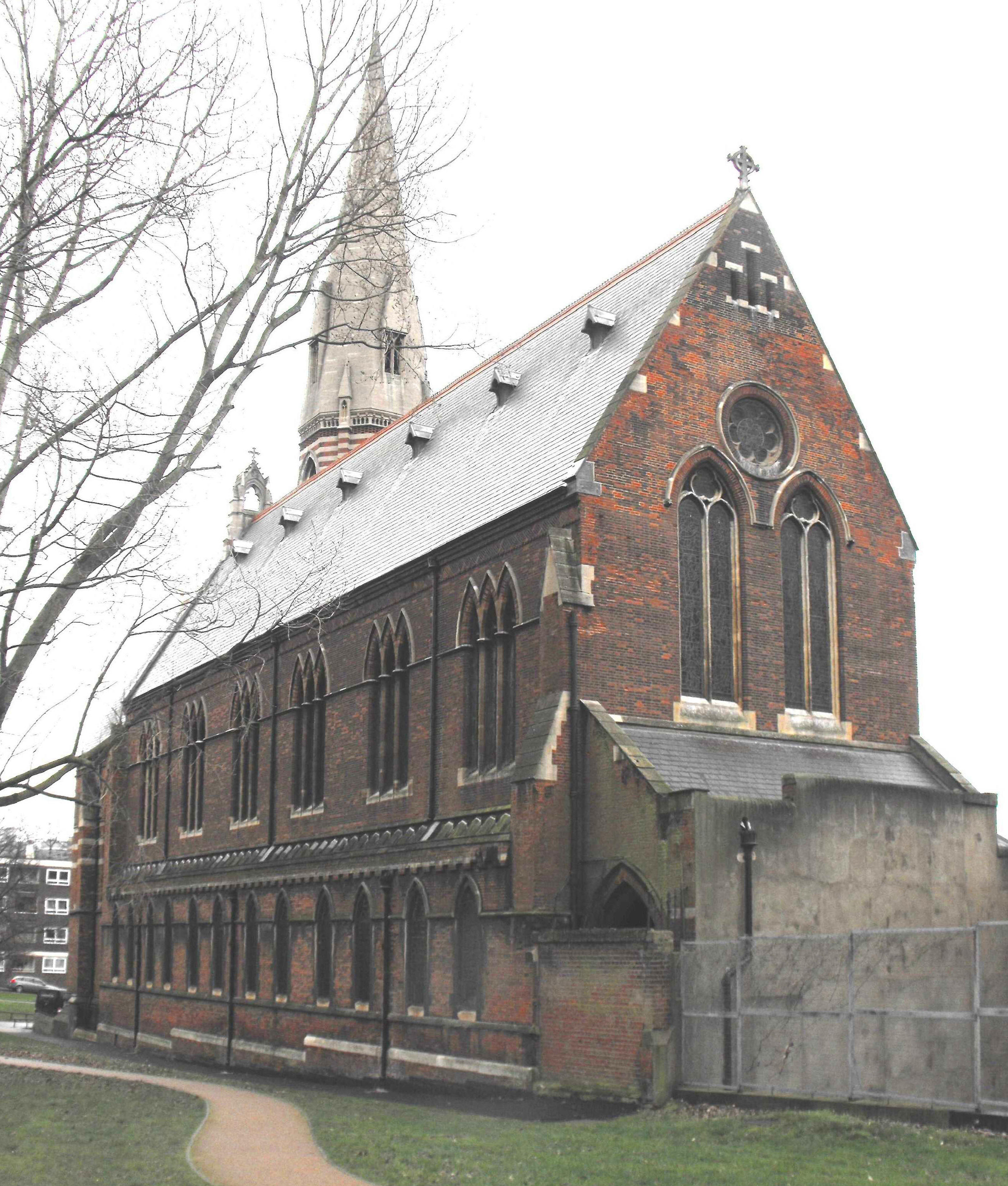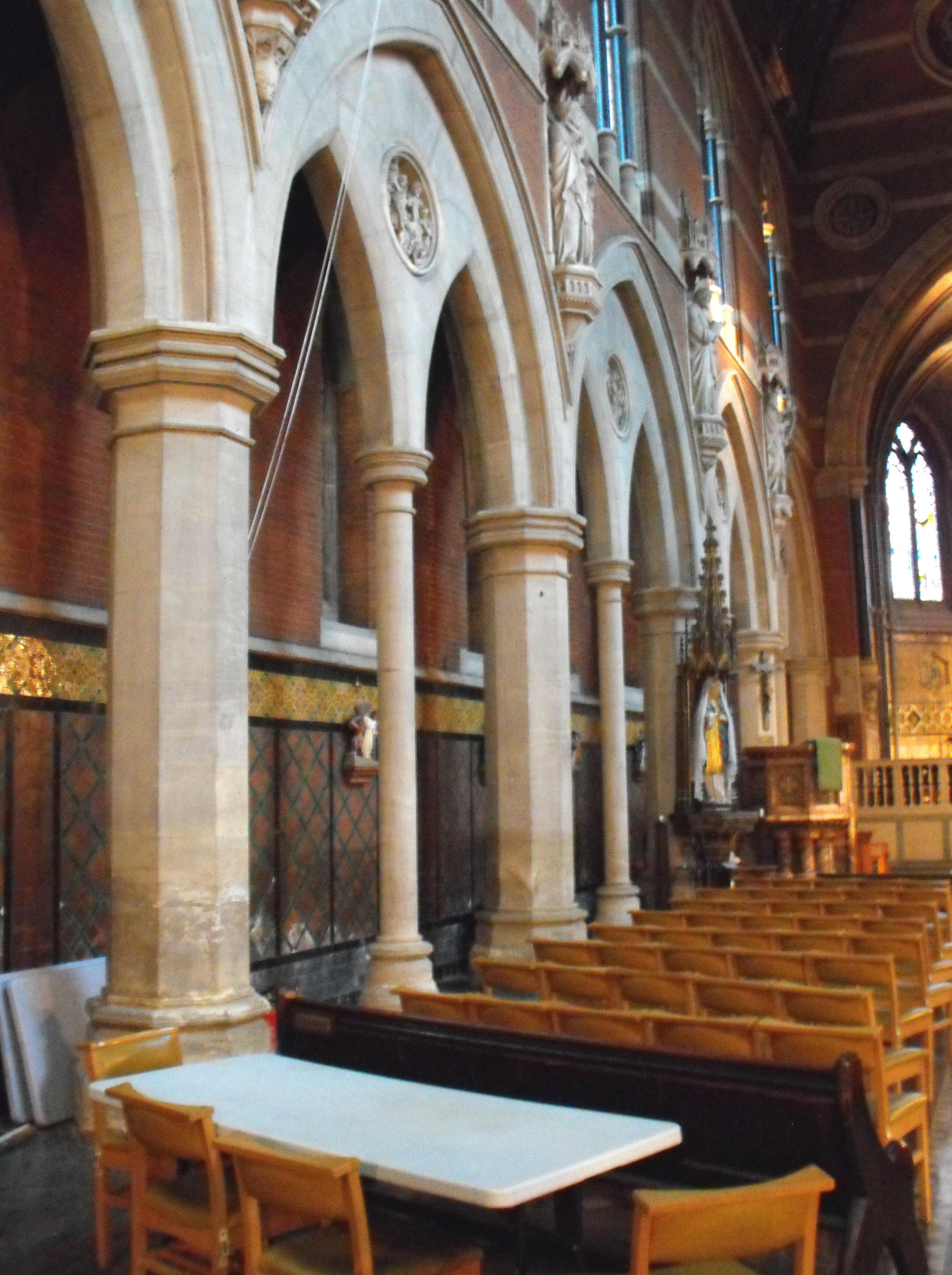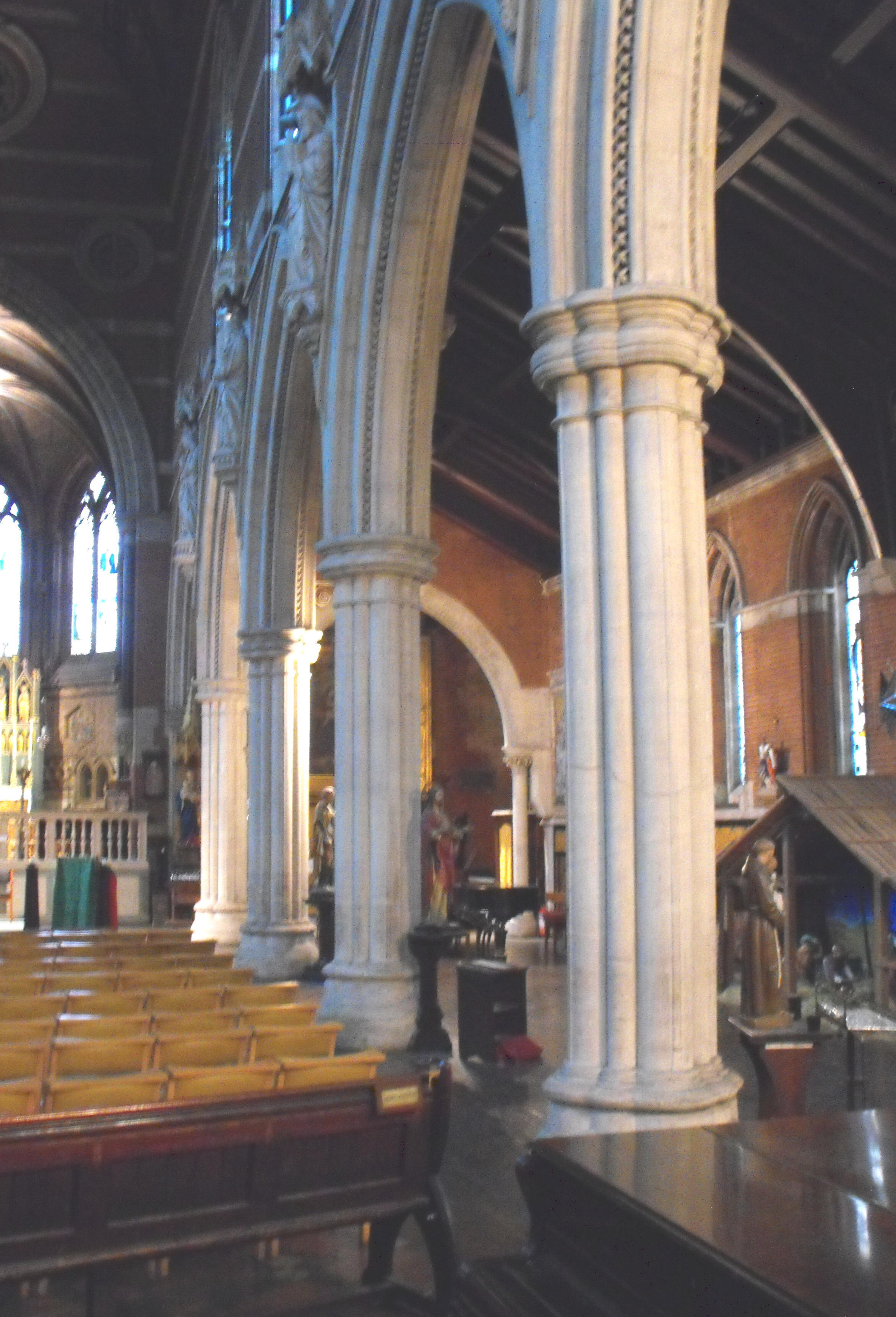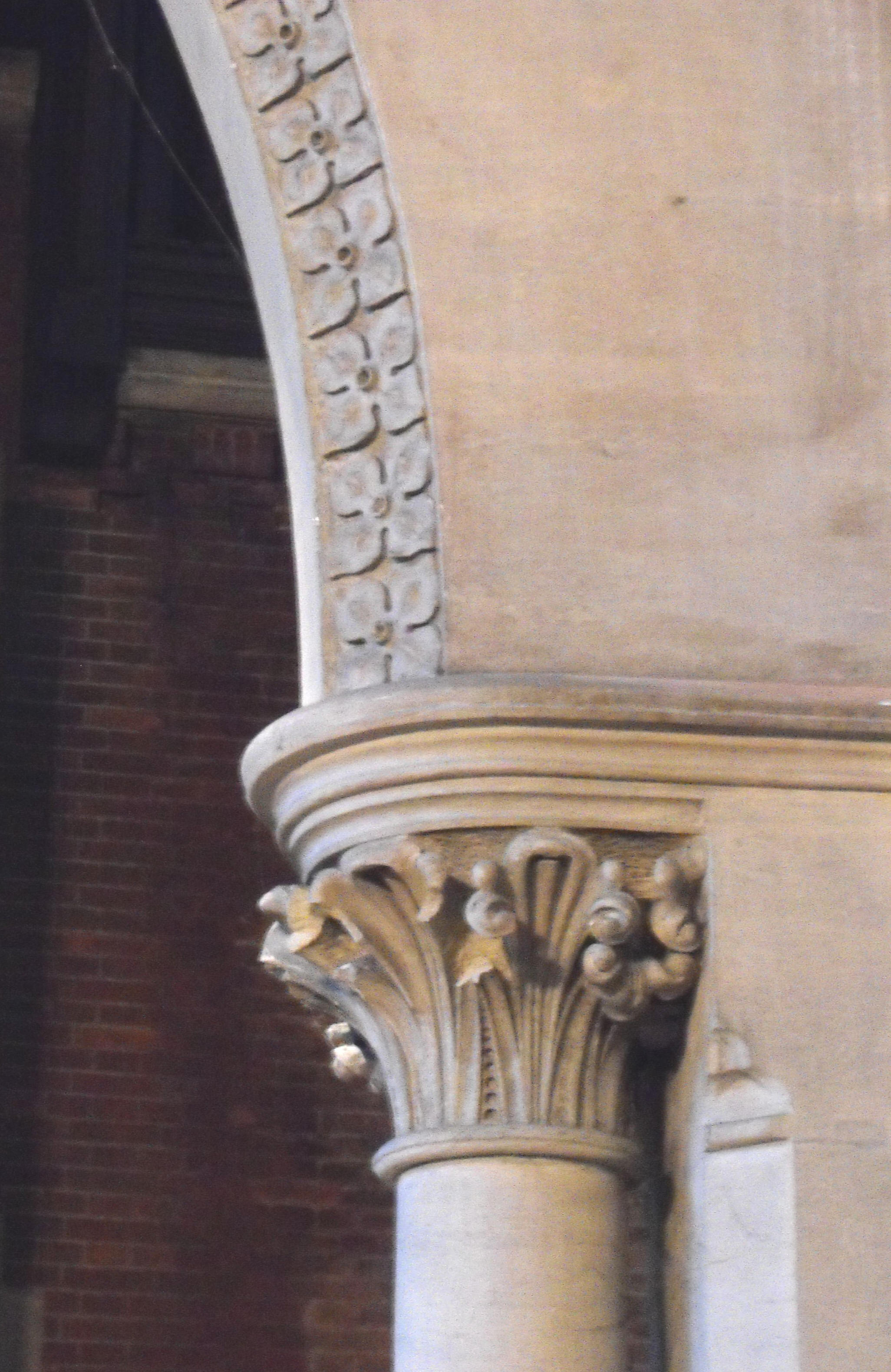|
(« back to home
page)
English Church Architecture.
WESTMINSTER,
St. Mary Magdalene Rowington Close
(TQ 265 820),
CITY OF WESTMINSTER.
An important
London church by one
of the foremost Victorian ecclesiastical architects,
George Edmund
Street (1824-81).
|
Famous, above all today, for the Law
Courts in The Strand, George Edmund Street was rivalled in his lifetime only by
William Butterfield as the architect of choice by the Anglo-Catholic wing of the
Church of England, and, indeed, in his personal attachment to High Church
ritual, he surpassed his rival and was for many years churchwarden at
Butterfield's 'model' church of All Saints', Margaret Street (Westminster),
after Butterfield had left, opposed to the use of incense and lights, and to the
Elevation of the Host. Yet for all his ardent religionism, it would be
entirely misleading to present Street as a humourless killjoy, for entirely to
the contrary, his two major publications, Brick & Marble in the Middle Ages:
Notes on a Tour of the North of Italy (London, John Murray, 1855) and
Some Account of Gothic Architecture in Spain (in two volumes) (London, John
Murray, 1865) are peppered with anecdotes about bad hotels and the sheer
awfulness of other English tourists encountered on the way, much to the
aggravation of The Ecclesiologist in its long review of the former in
October 1855 (vol. XVI, issue CX, p. 299): 'We cannot but think that
the ordinary reader of books of travel will be as much disturbed by Mr. Street's
purely professional descriptions and speculations as the architectural student
will be annoyed by the details of uncomfortable beds and ill-cooked dinners'.
Street's earnestness was sufficient for
most men, however, and his patrons, almost to a man and woman, were wealthy and
generous ones. Street was also an inveterate traveller, and a close
reading of Arthur Edmund Street's biography of his father (Memoir of George
Edmund Street, 1824-1881, London, John Murray, 1888) reveals that between
1850 and 1874, he made no less than twenty-two separate visits to the Continent,
including two such trips in 1872 and 1874 and only missing out on his working
vocations in 1855. 1864, 1865 and 1870, during the last of which, however, he
made a tour round Scotland. It is hardly surprising, in consequence, that
Street's architecture is the most eclectic among all his more important
confrères, and this is particularly striking in some of his village churches,
which in the most extreme cases, stand out from their settings as if they had
landed from the moon.
|

This is, externally at least, a severe inner city church by George Edmund Street
in an unfashionable part of the City of Westminster, made memorable by its polygonal apse and tall southeast tower and spire (seen left, in the view of the church from the
east). The nave S.
transept provides little more than a ceremonial entrance, and the crypt
owes its present form, including that of its half-exposed windows, to Sir
Ninian Comper (1864 - 1960).
There is much
that might be termed 'Ruskinian' here, though little that is not also
prefigured in Street's own writings, most notably in Brick and Marble. Built originally on a very constricted site in what
was then Woodchester Street,
between 1868 and '78, before slum clearance in the 1960s swept the road away
and made the church visible from angles
Street had never intended it to be seen (as in the view from the northwest, below right),
St. Mary Magdalene's is constructed of red brick with alternating stone
bands, below slate roofs of the steepest pitch, and has now lost much of
what must have been its early vibrancy beneath a century and a half of
London grime (though a visit in January does little to help). The tower's alien appearance
is the result, most especially, of the spire not being set back from the bell-stage, but it is not uncharacteristic of its
author (cf., for example,
East Heslerton in North Yorkshire) or of the High Victorian
period in general (see also Butterfield's
All Saints', Margaret Street in this borough, the same
architect's church at
Baldersby St. James in North Yorkshire, and in the same county, Pearson's church at
Appleton-le-Moors). The
stripy appearance of the bell-stage was presaged in a passage in Brick
and Marble (p. 273) in which Street praised the similar
treatment of the walls of S. Fermo Maggiore in Verona, which the present
building copies remarkably closely, albeit that the effect under an Italian
sky and in an atmosphere that has allowed the brick to remain red, was
something Street was never going to be able to recreate here.
Other features foreshadowed in Brick and Marble include the position
of the tower itself, attached to the south side of the chancel (as discussed in his description of churches in
Switzerland, p. 34), the form of the windows (based on the simple
traceries at Verona, composed of pairs of trefoiled lights with trefoils and
circles above, which Street praised on p. 79), the division of the clerestory lights by circular shafts
rather than mullions ('a feature so lovely and so perfect in every
respect, that one cannot but deeply lament that it was not more often
adopted in the North' - p. 261), and the absence of external
buttresses, around the apse in particular (as noted with approval at Venice,
p. 135). Such opinions,
stated so decidedly, may strike the modern reader not only as dogmatic but often
downright curious, but perhaps they are easier to understood as a consequence of exotic
foreign travel in an
exhilarating climate after a hard year's work in Victorian London. in North Yorkshire, and in the same county, Pearson's church at
Appleton-le-Moors). The
stripy appearance of the bell-stage was presaged in a passage in Brick
and Marble (p. 273) in which Street praised the similar
treatment of the walls of S. Fermo Maggiore in Verona, which the present
building copies remarkably closely, albeit that the effect under an Italian
sky and in an atmosphere that has allowed the brick to remain red, was
something Street was never going to be able to recreate here.
Other features foreshadowed in Brick and Marble include the position
of the tower itself, attached to the south side of the chancel (as discussed in his description of churches in
Switzerland, p. 34), the form of the windows (based on the simple
traceries at Verona, composed of pairs of trefoiled lights with trefoils and
circles above, which Street praised on p. 79), the division of the clerestory lights by circular shafts
rather than mullions ('a feature so lovely and so perfect in every
respect, that one cannot but deeply lament that it was not more often
adopted in the North' - p. 261), and the absence of external
buttresses, around the apse in particular (as noted with approval at Venice,
p. 135). Such opinions,
stated so decidedly, may strike the modern reader not only as dogmatic but often
downright curious, but perhaps they are easier to understood as a consequence of exotic
foreign travel in an
exhilarating climate after a hard year's work in Victorian London.
 Inside
the church, the unavoidably cramped building plan is revealed in the way the
S. aisle is opposed on the north side by the merest passageway, demarcated with a very different
arcade (shown left)
- in fact, a double arcade, whose task is to support the nave's
principal curtain wall. (See also the photograph, above right.)
The piers are octagonal and the intermediate shafts, circular. The stone
spandrels of the subsidiary arches house carved, inlaid roundels, depicting scenes leading
up to the Crucifixion (that is to say, in a less strict sequence than the Stations of the Cross). The brick spandrels of the main arches, both here and to the S.
arcade, contain
larger-than-life statues of assorted figures, including St. Mary Magdalene
and the four Evangelists, standing on brackets beneath crocketed canopies.
The S.
arcade (below right)
is constructed in six bays of arches of two orders bearing rolls, quadrant
mouldings and dog-tooth, springing from piers composed of four major and
four minor semicircular shafts. A triple arcade runs transversely across the
nave to the west, dividing off the church's expected principal Inside
the church, the unavoidably cramped building plan is revealed in the way the
S. aisle is opposed on the north side by the merest passageway, demarcated with a very different
arcade (shown left)
- in fact, a double arcade, whose task is to support the nave's
principal curtain wall. (See also the photograph, above right.)
The piers are octagonal and the intermediate shafts, circular. The stone
spandrels of the subsidiary arches house carved, inlaid roundels, depicting scenes leading
up to the Crucifixion (that is to say, in a less strict sequence than the Stations of the Cross). The brick spandrels of the main arches, both here and to the S.
arcade, contain
larger-than-life statues of assorted figures, including St. Mary Magdalene
and the four Evangelists, standing on brackets beneath crocketed canopies.
The S.
arcade (below right)
is constructed in six bays of arches of two orders bearing rolls, quadrant
mouldings and dog-tooth, springing from piers composed of four major and
four minor semicircular shafts. A triple arcade runs transversely across the
nave to the west, dividing off the church's expected principal entrance (through the S. door at the west end) in an arrangement seen on a much smaller
scale at
Wansford in the East Riding. The arch from the aisle to
the S. transept is formed of a single order, decorated on the respond with a
stopped chamfer and an order of shafts with stiff leaf capitals,
and around the arch, by stylised flowers resembling clematis.
entrance (through the S. door at the west end) in an arrangement seen on a much smaller
scale at
Wansford in the East Riding. The arch from the aisle to
the S. transept is formed of a single order, decorated on the respond with a
stopped chamfer and an order of shafts with stiff leaf capitals,
and around the arch, by stylised flowers resembling clematis.
 The
chancel arch is supported on black corbel shafts and the chancel itself consists of a
choir and an apse, the former covered by a single bay of quadripartite
ribbed vaulting and the latter, by a further bay with two additional
ribs to the east, which frame the E. window. The chancel was
re-ordered by Comper and the present steep ascent to the sanctuary is due to
him.
The dado around the sanctuary walls is panelled in plain
marble sheets below, and decorated above by an elaborate frieze of inlaid
patterns in circles and half circles, interrupted at intervals by carved
lozenges depicting the Seven Days of Creation. The triple sedilia recessed in the S. wall,
is formed of trefoil-cusped arches supported on quatrefoil marble shafts.
The stained glass in the windows around the apse and in the
nave W. window is by Henry Holiday (1839 - 1927),
a friend of John Ruskin, who succeeded Burne-Jones as designer at Powell's
Glass Works off London's Fleet Street, in 1861. Holiday was also working with Street at about the
same time, at
Robin Hood's Bay (North Yorkshire). The
chancel arch is supported on black corbel shafts and the chancel itself consists of a
choir and an apse, the former covered by a single bay of quadripartite
ribbed vaulting and the latter, by a further bay with two additional
ribs to the east, which frame the E. window. The chancel was
re-ordered by Comper and the present steep ascent to the sanctuary is due to
him.
The dado around the sanctuary walls is panelled in plain
marble sheets below, and decorated above by an elaborate frieze of inlaid
patterns in circles and half circles, interrupted at intervals by carved
lozenges depicting the Seven Days of Creation. The triple sedilia recessed in the S. wall,
is formed of trefoil-cusped arches supported on quatrefoil marble shafts.
The stained glass in the windows around the apse and in the
nave W. window is by Henry Holiday (1839 - 1927),
a friend of John Ruskin, who succeeded Burne-Jones as designer at Powell's
Glass Works off London's Fleet Street, in 1861. Holiday was also working with Street at about the
same time, at
Robin Hood's Bay (North Yorkshire).
Other furnishings in the church include the very
fine pulpit (below left), formed of an octagonal drum in mottled brown marble with inlaid patterns
in recessed panels, standing on eight short shafts with fillets. The less
interesting font (below right) is formed of a large but simple
circular bowl supported on a similar cluster of shafts but decorated only
with four drawn scenes from the life of Christ in trefoiled arches around
the sides.


[Other churches by Street
featured on this web-site are Fimber in the East Riding of
Yorkshire, Toddington in Gloucestershire, East Heslerton,
Helperthorpe, Howsham, Robin Hood's Bay, Thixendale, Wansford,
West Lutton and Whitwell-on-the-Hill in North
Yorkshire, Denstone in Staffordshire, Torquay in Torbay, Brightwalton and
Eastbury in West Berkshire, and St. James's Thorndike Street in the City of Westminster.] |

 in North Yorkshire, and in the same county, Pearson's church at
Appleton-le-Moors). The
stripy appearance of the bell-stage was presaged in a passage in Brick
and Marble (p. 273) in which Street praised the similar
treatment of the walls of S. Fermo Maggiore in Verona, which the present
building copies remarkably closely, albeit that the effect under an Italian
sky and in an atmosphere that has allowed the brick to remain red, was
something Street was never going to be able to recreate here.
Other features foreshadowed in Brick and Marble include the position
of the tower itself, attached to the south side of the chancel (as discussed in his description of churches in
Switzerland, p. 34), the form of the windows (based on the simple
traceries at Verona, composed of pairs of trefoiled lights with trefoils and
circles above, which Street praised on p. 79), the division of the clerestory lights by circular shafts
rather than mullions ('a feature so lovely and so perfect in every
respect, that one cannot but deeply lament that it was not more often
adopted in the North' - p. 261), and the absence of external
buttresses, around the apse in particular (as noted with approval at Venice,
p. 135). Such opinions,
stated so decidedly, may strike the modern reader not only as dogmatic but often
downright curious, but perhaps they are easier to understood as a consequence of exotic
foreign travel in an
exhilarating climate after a hard year's work in Victorian London.
in North Yorkshire, and in the same county, Pearson's church at
Appleton-le-Moors). The
stripy appearance of the bell-stage was presaged in a passage in Brick
and Marble (p. 273) in which Street praised the similar
treatment of the walls of S. Fermo Maggiore in Verona, which the present
building copies remarkably closely, albeit that the effect under an Italian
sky and in an atmosphere that has allowed the brick to remain red, was
something Street was never going to be able to recreate here.
Other features foreshadowed in Brick and Marble include the position
of the tower itself, attached to the south side of the chancel (as discussed in his description of churches in
Switzerland, p. 34), the form of the windows (based on the simple
traceries at Verona, composed of pairs of trefoiled lights with trefoils and
circles above, which Street praised on p. 79), the division of the clerestory lights by circular shafts
rather than mullions ('a feature so lovely and so perfect in every
respect, that one cannot but deeply lament that it was not more often
adopted in the North' - p. 261), and the absence of external
buttresses, around the apse in particular (as noted with approval at Venice,
p. 135). Such opinions,
stated so decidedly, may strike the modern reader not only as dogmatic but often
downright curious, but perhaps they are easier to understood as a consequence of exotic
foreign travel in an
exhilarating climate after a hard year's work in Victorian London.  Inside
the church, the unavoidably cramped building plan is revealed in the way the
S. aisle is opposed on the north side by the merest passageway, demarcated with a very different
arcade (shown left)
- in fact, a double arcade, whose task is to support the nave's
principal curtain wall. (See also the photograph, above right.)
The piers are octagonal and the intermediate shafts, circular. The stone
spandrels of the subsidiary arches house carved, inlaid roundels, depicting scenes leading
up to the Crucifixion (that is to say, in a less strict sequence than the Stations of the Cross). The brick spandrels of the main arches, both here and to the S.
arcade, contain
larger-than-life statues of assorted figures, including St. Mary Magdalene
and the four Evangelists, standing on brackets beneath crocketed canopies.
The S.
arcade (below right)
is constructed in six bays of arches of two orders bearing rolls, quadrant
mouldings and dog-tooth, springing from piers composed of four major and
four minor semicircular shafts. A triple arcade runs transversely across the
nave to the west, dividing off the church's expected principal
Inside
the church, the unavoidably cramped building plan is revealed in the way the
S. aisle is opposed on the north side by the merest passageway, demarcated with a very different
arcade (shown left)
- in fact, a double arcade, whose task is to support the nave's
principal curtain wall. (See also the photograph, above right.)
The piers are octagonal and the intermediate shafts, circular. The stone
spandrels of the subsidiary arches house carved, inlaid roundels, depicting scenes leading
up to the Crucifixion (that is to say, in a less strict sequence than the Stations of the Cross). The brick spandrels of the main arches, both here and to the S.
arcade, contain
larger-than-life statues of assorted figures, including St. Mary Magdalene
and the four Evangelists, standing on brackets beneath crocketed canopies.
The S.
arcade (below right)
is constructed in six bays of arches of two orders bearing rolls, quadrant
mouldings and dog-tooth, springing from piers composed of four major and
four minor semicircular shafts. A triple arcade runs transversely across the
nave to the west, dividing off the church's expected principal entrance (through the S. door at the west end) in an arrangement seen on a much smaller
scale at
Wansford in the East Riding. The arch from the aisle to
the S. transept is formed of a single order, decorated on the respond with a
stopped chamfer and an order of shafts with stiff leaf capitals,
and around the arch, by stylised flowers resembling clematis.
entrance (through the S. door at the west end) in an arrangement seen on a much smaller
scale at
Wansford in the East Riding. The arch from the aisle to
the S. transept is formed of a single order, decorated on the respond with a
stopped chamfer and an order of shafts with stiff leaf capitals,
and around the arch, by stylised flowers resembling clematis.
 The
chancel arch is supported on black corbel shafts and the chancel itself consists of a
choir and an apse, the former covered by a single bay of quadripartite
ribbed vaulting and the latter, by a further bay with two additional
ribs to the east, which frame the E. window. The chancel was
re-ordered by Comper and the present steep ascent to the sanctuary is due to
him.
The
chancel arch is supported on black corbel shafts and the chancel itself consists of a
choir and an apse, the former covered by a single bay of quadripartite
ribbed vaulting and the latter, by a further bay with two additional
ribs to the east, which frame the E. window. The chancel was
re-ordered by Comper and the present steep ascent to the sanctuary is due to
him. 
